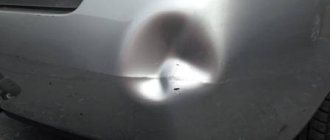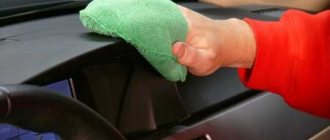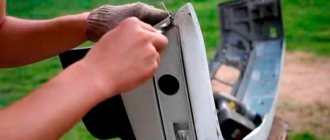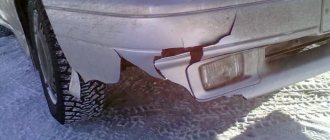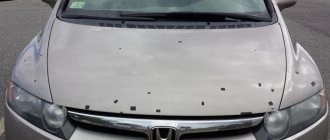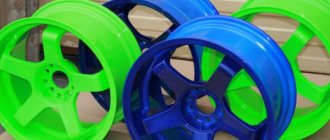Plastics have become a part of our lives. In many cases, plastic parts turn out to be more convenient, lighter, cheaper, and sometimes stronger than metal ones. But nothing lasts forever. Of course, a broken part is easiest to replace. And if this is not possible, it makes sense to try to repair it.
It is most often recommended to repair broken plastic parts by welding. High-quality welding produces a durable, and after appropriate processing, an almost invisible seam.
Unfortunately, welding is not always applicable. A significant part of plastics used in industry are thermosets and cannot be welded in principle. It is very difficult to weld thin plastic parts of complex shapes, which easily warp when heated. And in general, performing good welding is not easy. If you heat it up a little, the seam will become brittle; if you overheat it a little, the plastic of the part will begin to deteriorate.
Therefore, at home, it is more advisable to glue
. We will consider all stages of work using the example of one of the plastic parts of the interior lining of a car.
The edge of the thin plastic plate through which the part was attached to the body was broken off. The thickness of the plate is about a millimeter. Welding was immediately eliminated, since when heated to the melting temperature, the thin plate would inevitably warp. Let's try to glue it together!
The plastics used to make parts are extremely diverse. The industry uses several dozen different types of plastics, each of which has its own physical and chemical properties. Therefore, before starting repairs, you should determine the type of plastic from which the part is made.
How to determine the type of plastic?
If the size is not too small, then it is enough to inspect it carefully. Somewhere in a secluded place on the inside you will definitely find several letters - the part material code
. The date of manufacture may be indicated next to it, and for vehicle parts, the part number according to the spare parts catalogue.
If the part is imported, then the designation will most likely be placed inside or next to the recycling code - a triangle of three arrows closed on each other.
Plastic letter codes are standardized. The most common:
ABS
— acrylonitrile butadiene styrene (a very widespread material, especially for large parts of the external and internal decoration of cars, housings of household appliances, toys)
PA
— polyamide (due to wear resistance, especially with the addition of graphite, talc, fiberglass, oil, it is widely used for the manufacture of rubbing parts and gears of gearboxes)
PC
— polycarbonate (a transparent polymer used in the manufacture of lenses, compact discs, headlight lenses and flashlights; cellular polycarbonate is also widely used in the form of sheets with a cellular structure)
P.E.
- polyethylene (packaging film, boxes, cans, garden tools, water and sewer pipes, toys)
PP
— polypropylene (packaging film, bags, sewer pipes, disposable tableware)
PUR
— polyurethane (shoe soles, shock absorber bumpers, other elastic parts with high wear resistance)
Other symbols can be found in the complete list of symbols for technical plastics according to ISO 1043-1.
There are also combined types. For example, the part being repaired was marked ABS+PC
.
A mixture of ABS plastic and polycarbonate is widely used for the manufacture of car parts, so there is no mistake.
What kind of plastic can be glued?
An industrial production engineer will tell you that any plastic can be glued together. But he will also say that plastics are divided into three groups:
— easy to glue
requiring minimal surface preparation: ABS plastic (ABS, MABS), polyacrylate (PAK), polycarbonate (PC), cellulose-based plastics (CA, CAB, CAP, CN, CP, STA), unplasticized polyvinyl chloride (PVC-U) , epoxy resin-based plastics (EP)
— conditionally easy to glue
, requiring minimal surface preparation and the choice of special glue or primer: some types of polyamide without fillers (PA), polystyrene (PS), plasticized polyvinyl chloride (PVC, PVC-C), polyester plastics (PEEK, PEEST, PEI, REC, PESU, PEUR )
— difficult to glue
requiring special physical and chemical surface preparation: polyformaldehyde (CF, FF, MF, PF, UF), impact-resistant polystyrene (PS-HE), polypropylene (PP), polyethylene (PE), polyamides (PA)
At home, it makes sense to repair parts made of plastics of the first and, sometimes, second group. For example, polystyrene glues perfectly if you use glue based on dichloroethane or toluene (glue for plastic models).
The repaired part, made from a mixture of ABS plastic and polycarbonate, also belongs to the group of easy-to-glue parts and sticks well with almost any universal glue. In this case, maximum strength of the seam will be provided by EDP epoxy glue produced in Dzerzhinsk.
The glue is prepared in accordance with the instructions (10-12 parts of hardener per 100 parts of resin). It is very convenient to mix epoxy resin in a disposable polypropylene cup. Epoxy has very weak adhesion to polypropylene, so frozen residues from the glass are easily removed. And it wouldn’t be a shame to throw away such a glass either.
How to prepare surfaces for gluing?
When preparing plastic parts for gluing, it is best to follow the gluing instructions included with the adhesive. In general, preparation consists of cleaning
surfaces with fine sandpaper and
degreasing
with an organic solvent. For plastics, it is better to use ethyl alcohol, since some plastics may dissolve or swell in gasoline or acetone, which will reduce the strength of the adhesive seam.
Epoxy glue is applied in a thin layer to one or both surfaces to be glued, the parts are aligned and fixed. Unlike contact adhesives, epoxy resin does not require strong pressure; the joint can be secured by holding the parts with thread, rubber bands or clothespins. After 1-2 hours, the fixing devices should be removed
. Firstly, tearing them off later will be much more problematic. And secondly, the final polymerization of epoxy resin without external pressure will not allow internal stresses to form in the seam.
Bonding plastic parts with reinforcement
When gluing thin parts end-to-end, even the best glue will not be able to provide sufficient strength of the adhesive joint. The fact is that the strength of the seam depends on the area of contact
details.
In this case, the fragments of the part come into contact only along a thin fracture surface. Here it is advisable to use a reinforcing overlay
, especially since the gluing area is not in plain sight.
If the wreckage can be found, the job becomes easier. To begin with, you should try to glue the fragments in place with any suitable glue. You can use instant cyanoacrylate adhesive “Second” or contact polyurethane “Moment”.
After this, a pattern of reinforcing lining is made from paper. Special precision is not required here, since the overlay is then processed in place.
For the lining it is best to use fiberglass
, you can even foil. This is a very durable and resistant material based on epoxy resin. The thickness of the lining is selected based on the size of the part; in this case, 1.5 mm is sufficient. It is convenient to cut fiberglass with a hacksaw or a cutting disc of a hand engraver. Large parts can be cut with an angle grinder (“grinder”).
The overlay is glued in the usual way, allowing the epoxy resin to undergo final polymerization for at least 24 hours. The final processing of the overlay along the contour of the part is carried out with a file or engraver cutters.
The plastic part reinforced in this way is significantly stronger than the original one.
Plastic has many advantages, but it also has one significant drawback - fragility. Plastic products can crack, break, pieces can break off, etc. If the damage is significant, then it is easier to throw away the item and buy a new one than to repair it, but minor damage can be repaired with your own hands. Restoration of plastic can be carried out using different methods, the choice of which largely depends on the type of plastic itself. On many plastic products you can find markings with the composition of the plastic and this will help in choosing a restoration technology. So, thermosets are glued using a special glue, and thermoplastics are sealed. Also, the method of repairing plastic products depends on the nature of the damage - crack, scratch, chip, etc.
When repairing plastic items, you may need the following materials and tools: solvents (such as acetone), 1000-grit sandpaper, soldering iron or plastic glue, clamps, abrasive paste, brushes or syringe, solder, plastic cleaner, brass mesh, primer and paint for plastic, sanding machine, varnish.
Repairing plastic with epoxy resin
For this method you will need epoxy resin and hardener, fiberglass or sickle tape (sold in hardware stores), acetone, castor oil, a file and sanding paper, electrical tape or tape, plastic utensils and wooden sticks, primer for plastic, polyester putty, auto enamel.
You will need
- - soldering iron or glue;
- - acetone;
- - sponge;
- - emery;
- - fiberglass;
- - solder wire;
- - clamp or masking tape;
- — fittings;
- — primer for plastic;
- - dye;
- - varnish.
Instructions
Find out the composition of the plastic - its marking should be indicated on the back of the product (for example, PA - polyamide or PP -). It is important to study the properties of this material, since the type - gluing or welding - will depend on this. Thermoplastic polymers (plexiglass, polyethylene, polypropylene and others) are easy to recycle. But you won’t be able to melt the so-called thermosets (they contain phenol-formaldehyde, epoxy and other resins and fillers). You will need special glue.
Select an adhesive composition for the building material, epoxy for this type of plastic and consult with a competent seller. Follow the manufacturer's instructions exactly. Sand the surfaces to be glued, clean them of dirt and degrease with acetone. You can glue the crack directly along the seam, or pre-reinforce it with fiberglass.
Use solder wire of identical chemical composition to solder the leaky plastic part. Sand the working parts a centimeter from the edge, since the part to be welded will have to extend into the allowance left for the strength of the seam. Collect the broken plastic into pieces and secure them with a clamp (fixing tool) or masking tape.
Start thin plastic from the “face” so that an unsightly bump does not appear on the visible surface. Plastic of a denser composition can be repaired immediately from the reverse side. Run the soldering iron along the crack; apply solder and fuse it into the thickness of the softened material. On the reverse side of the work, you can use thicker wire.
Some craftsmen combine plastic soldering with reinforcement (strengthening the structure). To do this, it is recommended to purchase a special brass or bronze mesh (about 0.2 mm in thickness). Cut the reinforcing material into strips of the required size. Your task is to apply the amplifier to the inner surface of the chip and (heating the plastic with a soldering iron) drown it in the molten material.
Get ready for a plastic facelift. The glued or sealed surface must be washed, sanded with 1000 sandpaper and wiped with acetone.
Shake the can of plastic primer, shake it for 10 minutes and apply to the damaged part from a distance of 20 cm. If the packaging has other instructions, be sure to follow the manufacturer's instructions. Cover the plastic with 2-3 layers of primer (depending on the depth of the damage), let it dry and again go over the product with sandpaper and acetone.
The final stage of plastic repair will be spraying a special dye. Make sure it is designed specifically for the material. Apply the required number of decorative layers; Before each new coating, let the previous one dry for 15-20 minutes. If necessary, coat the product with varnish an hour after painting. You managed to repair the plastic, but until it dries completely it must be protected from dust and other contaminants.
Often we need to glue a broken or cracked plastic product - from the temple of glasses to the bumper of a car. It may also be necessary to glue a hook in the bathroom or a holder for a garden sprayer. The essence of the gluing process is to dissolve the surface layer of two workpieces and form from this solution a layer of plastic common to both parts. After hardening, the parts form a single whole, or, as they say, “glue tightly together.”
Cold welding
Modern cold welding is a special adhesive based on epoxy and amine resins, supplemented with a metal or mineral type filler. Application does not require special skills or professional tools.
Work technology:
- Clean the surface to be repaired from dirt.
- Sand the area to be glued with sandpaper.
- Degrease the surface with any alcohol-containing solution.
- Apply adhesive.
The rules for applying the composition depend on the type of product used. Today, cold welding is produced in the form of a homogeneous soft mass, reminiscent of plasticine, as well as two- and one-component adhesive.
Determining the type of plastic
In order to reliably glue plastic, you first need to find out what kind of plastic the object is made of. Knowing the plastic, you can choose the most suitable adhesive for it.
All manufacturers put recycling symbols on their plastic products - this is the well-known Recycling Triangle - a triangle with arrows on the sides, symbolizing the reuse of materials.
The triangle contains numbers from one to seven. Often the numbers are supplemented by an abbreviation. These designations are used to determine the type of plastic.
What does the marking on plastic mean?
- PET low density polyethylene or polyethylene terephthalate. It is mainly used for packaging or packaging food products. Available in the form of film, bags or transparent containers for liquid and bulk goods, as well as drinks.
- HDPE compacted low pressure polyethylene. Used for the production of shrink film and packaging bags.
- V (PVC) polyvinyl chloride is a non-food plastic used for the manufacture of strong and durable items, such as household buckets, metal-plastic window frames, and linoleum.
- LDPE Low density polyethylene of high pressure. Used in the production of bottles for drinks and dairy products, packaging bags, toys, cold water pipes.
- PP polypropylene. Plastic is not chemically active, heat-resistant (up to 150 °C), and is most widely used in the production of medical goods, heat-resistant dishes and household utensils, toys, pipes and fittings for hot water, and much more.
- PS polystyrene. Also food grade plastic, it is used to make disposable tableware, household utensils, and kitchen appliance housings. If it is foamed, it forms an excellent porous heat insulator - polystyrene foam, used in everyday life and in construction work.
- O Other (others) - materials that are not intended for recycling, for example, with inclusions of metal, paper or other substances). This also includes plastics that do not belong to one of the six groups.
PS - polystyrene
To reliably glue plastic, you need to carefully examine the markings on the product and select an adhesive intended for polymers of this group. There is another way to determine the type of plastic - a small piece of it must be set on fire. Each type burns with a characteristic smell and type of flame. To reliably use this method at home, you need to gain considerable experience.
Preparing the soldering iron
- Models with temperature controller. There are many types of soldering irons and soldering stations. In addition to the usual classic ones, there are a number of models in which you can set the desired temperature. If plastic is heated too much, it can lose its original properties, weaken and break. Exposure to high temperatures also causes the formation of toxic smoke.
- Flat tip models. For soldering plastic, it is best to use a flat tip. But if you don’t have one, you can flatten the existing one. This can be done by first tapping it with a hammer and then squeezing it in a vice.
Glue marking
Tubes with glue are also marked, it’s just a pity that the designation system does not always coincide with the designations in the triangle on the plastic product. Most often you can see the following symbols on the tube:
- PC-polycarbonate (used for covering greenhouses and canopies).
- ABS is an acrylonitrile copolymer.
- PP polypropylene.
- PPMA organic glass for general purpose.
- PE is a well-known polyethylene.
- PVC is another familiar one - vinyl, or polyvinyl chloride.
- PS – polystyrene.
- PA 66 - polyamide.
- PUR polyurethane.
If you are not an expert in organic chemistry, then most likely, further study of labeling at home will not be successful. It is better to read in the user manual, which must be included with the tube, which plastics can be glued with it.
How to repair a crack in plastic?
Usually the issue is resolved with the help of a kit for repairing plastic containers, but remember, if you want to use this method for a long time, such repairs will not help you. All capacitive products in 95% of cases are made from two materials: polypropylene (PP) and polyethylene (PE), which in turn have very low adhesion, that is, very resistant to chemical influences. Almost no glue sticks to them, and no patch with glue will provide a high-quality repair; professional repairs using welding are necessary!
How to seal a plastic gas tank?
How to seal a plastic gas tank is a serious question; not every car service center has specialists who can restore a plastic fuel tank and, moreover, give a guarantee for sealing! You can repair it yourself, but again you need equipment and a simple hair dryer is unlikely to save you, where will they give you a guarantee for their repair? Our workshop both repairs and provides a guarantee for the repair of the fuel tank; specialists travel to the repair site if necessary by agreement.
Types of adhesives
The variety of plastics used in everyday life corresponds to an equally wide variety of manufactured compositions and methods of their use.
How to glue plastic
To dissolve the surface layer of a material, it is necessary to destroy the chemical bonds between the molecules. For this purpose, special substances are used - strong solvents. Each solvent is suitable for its own group of plastics, and may not even leave a trace on a material from another group. The basis of each adhesive composition is such a solvent. In addition, the composition may include:
- a hardener that promotes drying;
- filler - dissolved molecules of the substance for which the glue is intended.
One of the strongest solvents is dichloroethane. It is used to glue polystyrene and plexiglass.
Depending on the method of use, the products are divided into several groups:
- liquid;
- contact;
- reactionary;
- hot melt adhesives.
Liquid
Liquid ones are widely used in everyday life; they are easily and simply used at home for gluing plastic that has a porous structure. They are produced both on the basis of an organic solvent and on a water basis. They are applied to surfaces that are pressed against each other for a time sufficient for the base to evaporate. After this, the adhesive layer hardens, forming a connecting seam. A typical example is PVA glue; it can be used to glue not only linoleum, but also wood at home.
Contact
Bonding takes place in two stages:
- the surfaces to be glued are lubricated with a thin layer, which dissolves the surface layer of plastic, softening it and facilitating contact with another surface;
- After a few minutes, the parts are pressed against each other with force, the softened layers are mixed, the solvent evaporates and a seam is formed.
This is how Moment, BF-2 and others work. They can be used to glue polystyrene and other plastics together at home. They contain toxic substances, so you need to work in a well-ventilated area and prevent drops from coming into contact with the skin or mucous membranes.
Reactionary
One-component reactive agents dissolve the bonded material very quickly and harden just as quickly. These are such well-known brands as Secunda, Superglue and their analogues. The seam is strong and rigid.
Two-component ones consist, respectively, of two components stored separately from each other:
- hardener;
- fixative
The components are mixed immediately before use and applied to the surface, where the mixture hardens to form a compound. The basis is epoxy or polyester resins. The seam at home turns out to be very durable. A characteristic feature is that complete hardening takes quite a long time, and the seam gradually increases both strength and fragility.
Hot melt adhesives
This group includes substances that exhibit their properties when heated to 110-120 °C. To use, you need a special glue gun with a heating element. Differs in precision of application. In addition to plastic, it can be used to glue wood, fabric, and paper together at home.
“Rivet” repair
The rivet method is similar to the first. You can try to fix a leak in a plastic bucket this way if you don’t have superglue on hand. It is necessary to cut out rubber patches and similarly sized fragments of a tin plate of the same size. Holes are drilled in them, as well as in the bucket.
In the next step, a rubber pad is placed on the surface of the “wounded” container at the site of damage, and a tin can is placed on top of it. Also on the other side. A rivet is inserted into the hole and riveted using a hammer. The same manipulations are carried out with the remaining rivets. Due to the fact that the plates press the rubber on both sides, the crack is hermetically sealed.
How to glue plastic tightly at home
After the type of plastic has been determined and the appropriate substance has been selected, you should:
- Thoroughly degrease the surfaces to be bonded. To do this, use alcohol, a degreaser or a soap solution (only laundry soap);
- To glue objects more reliably, you need to increase wettability. To do this, treat the surface with a velvet file or fine sandpaper;
- Mix two-component reactive substances only after completing the preparation of parts;
- do not use brushes with natural bristles;
- Apply enough adhesive so that when pressing the workpieces, the excess is not squeezed out beyond the gluing zone.
The parts should be pressed so as to prevent their displacement in the gluing plane relative to each other.
Industrial dryer
An industrial hair dryer for performing household welding of polymers has the most minimal functionality, but allows you to easily eliminate cracks, as well as restore the integrity of various plastic products.
Work technology:
- Place a plastic rod into the crack.
- Heat the plastic and edges evenly with a welding hair dryer.
- Melt the rod completely before mixing it with the plastic.
- Wait until the seam hardens evenly.
After cooling, all excess is removed from the surface, and the welding area is carefully sanded using fine-grained sandpaper or a grinding wheel.
A burst or cracked bucket can be sealed or welded, but any such measures are considered to be exclusively a temporary control measure, and further destruction of the plastic is an irreversible process.
How to achieve maximum effect when gluing plastic parts
To ensure maximum effect when gluing plastic at home, you should:
- accurately determine the material and select the appropriate adhesive for it;
- carefully follow the instructions for use;
- wait for the required time for the seam to gain strength and do not try to use the product ahead of time;
- for outdoor use or for items used in high humidity conditions, you need to choose a waterproof brand;
- despite the declared heat resistance of the adhesive, the parts themselves may not survive this temperature;
- If there is no marking on the product, then you can try dropping a drop of adhesive in an inconspicuous place and see if the material dissolves.
Epoxy glue produces one of the strongest bonds and is compatible with many types of plastics.
How to seal a plastic container
Is it even possible to seal a plastic container or gas tank?
How to seal a plastic container? Nowadays, there are many invented ways to weld cracks, holes, burst seams, the equipment for such repairs is also varied, from a soldering iron to a hair dryer, whatever you need. It can be repaired with such tools, but where is the guarantee that it will not leak again. Such repairs will be simply decorative and the owner will incur new expenses in the future. Requires knowledge of the material and practice. Our craftsmen use professional equipment from a well-known Swiss company and provide a guarantee on the repaired container, tank, tank, or gas tank made of plastic.
What affects the reliability of gluing
The reliability of the seam is influenced by a number of conditions. All of them are important, and failure to comply with any one can lead to the fact that what is glued at home will fall off, despite compliance with all the others. So:
- Compliance of the product material and adhesive composition.
- Correspondence of the type of adhesive composition to the magnitude of the forces that the connection will experience. The direction of these efforts is equally important. Thus, compounds that produce rigid seams are not suitable for repairing, for example, shoes - after all, the sole will bend and twist during use, despite the fact that the tensile force will be small. At the same time, this composition can successfully glue, say, a hook to glass, and hang tens of kilograms on it.
- Compliance with application technology. Everything is important here - how many seconds or minutes the surfaces need to be compressed, and how to degrease them, and how long to keep the parts pressed against each other. All this depends on the properties of a particular “plastic-glue” pair, is described in detail in the instructions and must be followed verbatim. A deviation of one second in the exposure time or premature start of use of the product can lead to secondary failure.
- Mechanical part of the process. It is important to thoroughly clean the surface from dust and roughen it. In addition, the direction of pressing the parts against each other must be perpendicular to the surfaces being glued. You should not allow the parts to move mutually after pressing - this will also lead to failure.
Gluing plastic tightly is not so easy. Carefully following simple rules by the home craftsman will allow you to obtain strong and durable connections. The main thing is not to forget about safety precautions: do not inhale vapors of the adhesive and do not allow it to get into food, skin or mucous membranes. If accidentally swallowed, consult a doctor immediately, making sure to take the tube with you.
The window sill is an integral part of the window opening. And since PVC windows are now a big priority, this part should also be made of plastic. Without this element, the interior of the room looks unfinished and uncomfortable.
But with prolonged and improper use of window sills on a variety of surfaces, this part of the window may require restoration. And we don’t always know how to update and how to repair a plastic window sill if cracks and chips appear, not to mention the change in color and deformation.
How and how to repair a hole in a plastic pipe - methods tested by experts
I tried to glue it, but nothing helped; under the weight of the water, the barrel still leaks along with the holes. Please advise what can be done. The container is in the attic, and there is no need for dampness there. Grekus
October 23, 2015 at 6:18 pm Need to solder. Same material as solder. Treat the place where the crack/hole is for welding. Dominic
October 24, 2015 at 5:53 Place the patches and tighten them with bolts rocksinataha October 25, 2015 at 0:15 You can try dichloroethane, this is an interesting mixture that you need to spread on the surfaces to be glued, wait until the plastic dissolves, then press them together and wait a little until it sets. homohilaris
October 25, 2015 at 7:45 am If the hole is small. You need to look in construction stores for welding for plastic or liquid plastic in tubes. We tried welding when we reanimated two large buckets and a two-bucket basin. Now we keep a supply of water in them in case of blackouts. Nothing is leaking. You just need to do everything strictly according to the instructions, without deviations. Renton
October 25, 2015 at 9:02 am As an option. You can also try soldering it the way bumpers on cars are soldered. A heat gun with additives for heat sealing is used and a reinforcing mesh is also needed. Go to a service station and consult with a specialist. As far as I have seen such repairs, the process is generally not complicated. Tim
October 28, 2015 at 1:50 p.m. I have the same problem, although the container is smaller - only 50 liters - last winter I filled up with water, pulled the container through the snow and lightly caught an ice floe - a crack of about 15 centimeters. I'm thinking of sealing it with polyethylene glue. Maksimka
October 28, 2015 at 03:07 pm It may be a stupid method, but it seems to me that you should place a cut out plastic circle on top of the hole. Slightly wider than the hole. And try to solder this circle. As mentioned above, use plastic solder. It is sold in construction stores. Soldering only the hole will not help. Verified. Renton
October 29, 2015 at 7:09 You can try it too. It’s just that, as it seems to me, it’s necessary to throw a fine mesh under the plastic “patch” as reinforcement. There is one for solder. Then, perhaps, it will be possible to hold the soldering area.
When is restoration necessary?
Plastic is a relatively practical material. Elements made from it are easy to maintain, easy to install, have a wide range of colors and are low in price. But at the same time, they are susceptible to mechanical damage and sensitive to elevated temperatures (they swell and can crack).
What to do if the following appears on the windowsill:
- Chips, cracks and scratches.
- Traces from flower pots and hot objects.
- Spots faded by sunlight.
- Damage caused by chemical surface cleaning agents.
The plastic surface of the window sill is subject to mechanical damage.
In this case, repairs of plastic window sills are carried out depending on the degree of damage. There are special restorative agents for these purposes. If these are minor damages, the repair is done using putty; for multiple chips and cracks, a laminated film is used, and for serious problems, a special overlay is used.
How to repair minor damage to a plastic car bumper
Bumper damage comes in many different types, from minor scratches and small dents to serious cracks. Small dents and scratches can be removed yourself.
If the car bumper is made of thermoactive plastic, then minor damage to it can be easily eliminated using the polishing method with special chemicals. means.
For example, if there is a shallow scratch, it can be treated with WD-40 universal cleaner.
In order to polish a scratch or chip, you will need a sponge, a soft rag and a chemical reagent. First, you need to clean the damaged area from dirt and dust with a sponge and water. After applying chemical. spray or sponge. Next, the damaged area is intensively polished with a rag until no damage is visible on it.
The second way to eliminate small dents and scratches on a plastic car bumper is to straighten the damaged area with a hot air gun. The essence of the method is that the damaged surface is evenly heated with a hair dryer. Due to heat treatment, the damage is leveled and straightened.
The method is simple and does not require special skills to perform, but it is not without its drawbacks: there is a possibility of deformation of the plastic; heating with a hairdryer can only be used on unpainted areas.
Ways to solve the problem
Let's break down the options for restoring PVC window sills into categories depending on the use of the material used.
Important! Before you repair a plastic window sill with your own hands, the surface must be cleaned of dirt, degreased with alcohol and dried.
Chemical cleaners
It is known that the plastic surfaces of windows and window sills are covered with an invisible or decorative film that performs a protective function. If handled carelessly, it will become scuffed and yellowed. To eliminate such minor defects, you can completely restore the part using laminate wax or a special solvent-based Cosmofen cleaner.
Small stains and abrasions can be removed with a special cleaner Cosmofen
If the window sill is completely yellowed, it is better to apply the composition to its entire surface. It will dissolve the top yellowed layer and the plastic will become as good as new. This will complete the restoration of the window sill.
Special putty
The use of a specialized mixture such as Fenoplast or Reparaturset to seal small defects is a very popular method today. In stores it is sold in powder form complete with a spatula and measuring cup. Preparing the putty according to the instructions is not difficult. After use, this mixture acquires properties close to PVC and easily covers gaps, be it a crack or a scratch. To dilute the two-component mixture, experienced specialists use not water, but a primer for deeper penetration, which helps to obtain a fairly durable coating.
You can use putty to repair small scratches and cracks.
Immediately after preparing the composition you should:
- Apply putty to the surface.
- Carefully repair the scratch and smooth it out.
- Wait 10-15 minutes. until completely dry.
- Sand with sandpaper.
- Polish with Fenosol S5 “UVA”.
To understand what it will look like to repair a plastic window sill with your own hands using putty, you need to start with more inconspicuous places.
Liquid plastic
If you don't know how to remove scratches from a plastic window sill, use liquid plastic. This material is absolutely indispensable for repairing deep scratches and large dents. It allows you to restore even the most advanced deformation.
To correct deep defects in the window sill, liquid plastic is used
With a ready-made composition such as Cosmofen Plus, all the recesses on the plastic window sill are sealed until a smooth surface is obtained. After this, you need to see how the cracks being repaired and the patch will differ from the overall texture of the plate. Therefore, it can additionally be covered with self-adhesive decorative film.
Laminated Film
This is a fairly simple and affordable option for restoring the surface of plastic windows with numerous defects. A wide variety of colors and a choice of assortments to imitate various textures (wood, stone, Russian pattern, etc.) make this product very popular even when restoration of the plastic window sill is not required.
Using laminated film you can update an old window sill
To use the film you should:
- Apply putty mixture.
- Use sandpaper to remove any bulges.
- Cut the film to the required size with a margin of 2-3 cm at the edges.
- Gently spread it over the surface with a towel.
- Remove any air bubbles that have formed by piercing them with a needle and level the surface.
- Glue the film in hard-to-reach places using a hairdryer, which will make it more elastic.
The easiest way to do the work is with two people, when one holds the edge of the glued film, and the other removes its inner layer.
Important! Before repairing window sills, it is better to disconnect this element from the window. This will allow you to deal with the problem more quickly and efficiently.
PVC lining
Repairing a window sill using a special overlay is suitable for elements no more than 6 cm thick. This is a fairly economical and completely simple method in terms of labor costs, when you can simply close the problematic part. For example, when an element might swell or become severely cracked. The PVC window sill cover is made of pure polyvinyl chloride, which is durable and resistant to moisture and ultraviolet radiation, and allows you to get an updated interior in a matter of hours.
To install it you need:
- Fill large damage with glue.
- Cut the trim to fit the size of the window sill.
- Degrease the surface and coat with glue.
- Place the trim on the window sill and press down with a weight.
- Leave until completely dry for 5-6 hours.
- Fill the voids between the window sill and the trim with silicone sealant.
- Place the end caps on the glue.
After the plastic covers on the window sills are glued, the protective film is removed. White plastic linings are considered the least problematic. After gluing to the old window sill, the edge of the plate is heated with a hair dryer and bent to its shape.
Plastic cover allows repairs to be carried out in a short time
Important! Heat treatment cannot be applied to laminated and glossy overlays, as they immediately lose their attractive appearance
.
How to seal plastic cracks in a refrigerator?
Most often, sewer systems are repaired in this way.
In this case, you need to act like this:
- Clear and expand the damage. This is done to ensure deeper penetration of the sealant.
- Degrease and dry the repaired area.
- Apply the required layer of sealant and let it dry thoroughly.
However, it happens that the pipe receives through damage. How to seal a sewer plastic pipe in this case?
This is done using a two-component epoxy composition, following the following sequence of work:
- The area where the damage occurred must be cleaned, degreased and dried.
- To prepare the bandage you will need fiberglass or other dense and flexible material.
- The prepared bandage is used to wrap the crack itself and the area around it, with a good margin. You need to wrap the material around the pipe at least 5 times.
- At the final stage, epoxy glue is applied.
In addition to sewer systems, water pipes and heated towel rails can be repaired in this way.
